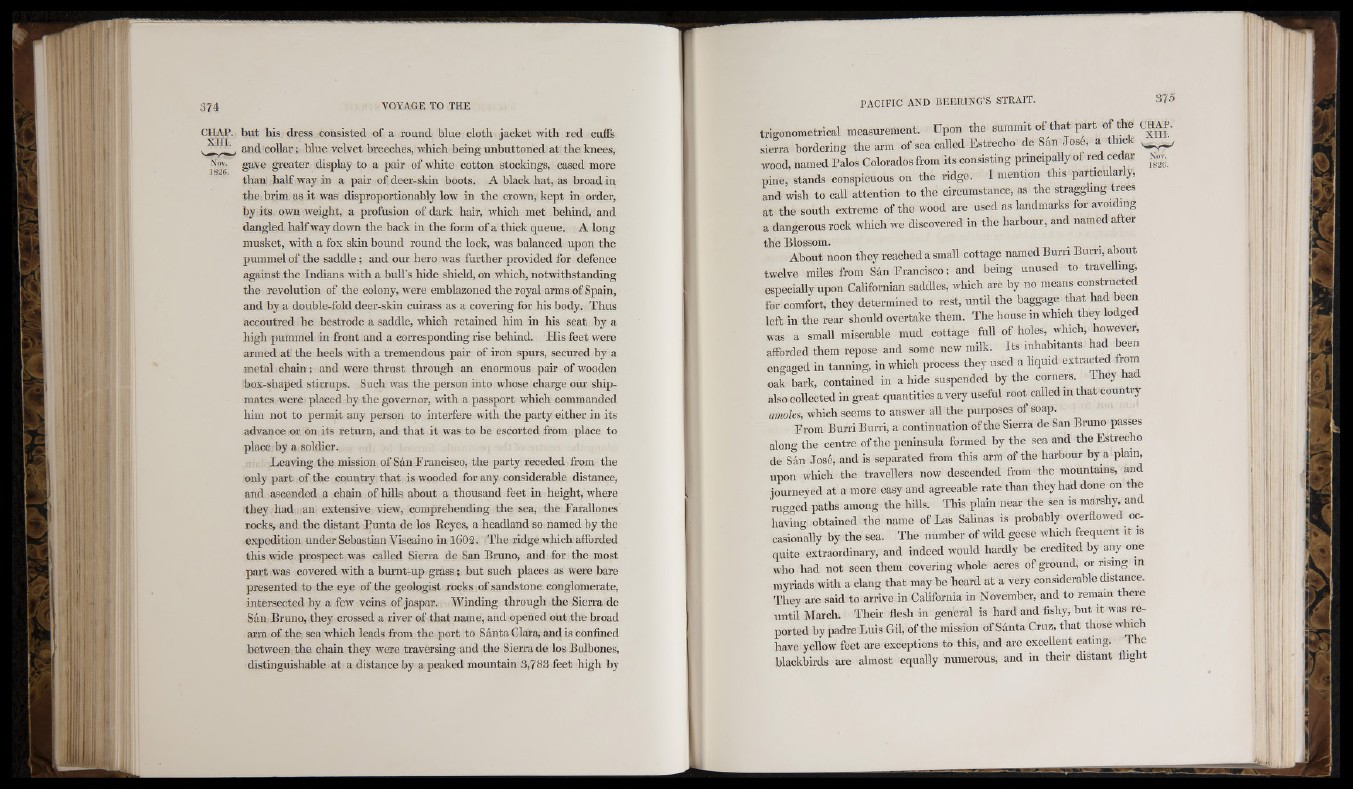
Nov.
182G.
1
CHAP. b u t his dress consisted o f a ro u n d blue c lo th ia ck et with red cuffs
XIII and collar; blue velvet breeches, which being unbuttoned at the knees,
gave greater display to a pair of white cotton stockings, cased more
than half way in a pair of deer-skin boots. A black hat, as broad in
the brim as it was disproportionably low in the crown, kept in order,
by its own weight, a profusion of dark hair, which met behind, and
dangled halfway down the back in the form of a thick queue. A long
musket, with a fox skin bound round the lock, was balanced upon the
pummel of the saddle; and our hero was further provided for defence
against the Indians with a bull's hide shield, on which, notwithstanding
the revolution of the colony, were emblazoned the royal arms of Spain,
and by a double-fold deer-skin cuirass as a covering for his body. Thus
accoutred he bestrode a saddle, which retained him in his seat by a
high pummel in front and a corresponding rise behind. His feet were
armed at the heels with a tremendous pair of iron spurs, secured by a
metal chain; and were thrust through an enormous pair of wooden
box-shaped stirrups. Such was the person into whose charge our shipmates
were placed by the governor, with a passport which commanded
him not to permit any person to interfere with the party either in its
advance or on its return, and that it was to be escorted from place to
place by a soldier.
Leaving the mission of Sán Francisco, the party receded from the
only part of the country that is wooded for any considerable distance,
and ascended a chain of hills about a thousand feet in height, where
they had an extensive view, comprehending the sea, the Farallones
rocks, and the distant Punta de los Eeyes, a headland so named by the
expedition under Sebastian Viscaino in 1602. The ridge which afforded
this wide prospect was called Sierra de San Bruno, and for the most
part was covered with a burnt-up grass; but such places as were bare
presented to the eye of the geologist rocks of sandstone conglomerate,
intersected by a few veins of jaspar. Winding through the Sierra de
Sán Bruno, they crossed a river of that name, and opened out the broad
arm of the sea which leads from the port to Sánta Clara, and is confined
between the chain they were traversing and the Sierra de los Bolbones,
distinguishable at a distance by a peaked mountain 3,783 feet high by
trigonometrical measurement. Upon the summit of that part of the cHAP.
sierra bordering the arm of sea called Estrecho de Sán .lose, a thick
wood, named Palos Colorados from its consisting principally of red cedar Nov
pine, stands conspicuous on the ridge. I mention this particularly,
and wish to call attention to the circumstance, as the straggling trees
at the south extreme of the wood are used as landmarks for avoiding
a dangerous rock which we discovered in the harbour, and named after
the Blossom. . v +
About noon they reached a small cottage named Burn Burn, about
twelve miles from Sán Francisco ; and being unused to travelling,
especially upon Californian saddles, which are by no means constructed
for comfort, they determined to rest, until the baggage that had been
left in the rear should overtake them. The house in which they lodged
was a small miserable mud cottage full of holes, which, however,
afforded them repose and some new milk. Its inhabitants had been
engaged in tanning, in which process they used a liquid extract^ froin
oak bark, contained in a hide suspended by the corners. They had
also collected in great quantities a very useful root called in that country
amoks, which seems to answer all the purposes of soap.
From Burri Burri, a continuation of the Sierra de San Bruno passes
along the centre of the peninsula formed by the sea and the Estrecho
de Sán José, and is separated from this arm of the harbour by a plain,
upon which the travellers now descended from the mountains, and
journeyed at a more easy and agreeable rate than they had done on the
ruo-cied paths among the hills. This plain near the sea is marshy, and
h a L g obtained the name of Las Salinas is probably overflowed oc-
casion"ally by the sea. The number of wild geese which frequent it is
quite extraordinary, and indeed would hardly be credited by any one
who had not seen them covering whole acres of ground, or rising in
myriads with a clang that may be heard at a very considerable distance.
They are said to arrive in CaUfornia in November, and to remain there
until March. Their flesh in general is hard and fishy, but it was reported
by padre Luis Gil, of the mission of Sánta Cruz, that those which
have yellow feet are exceptions to this, and are excellent eating. The
blackbirds are almost equally numerous, and in their distant flight